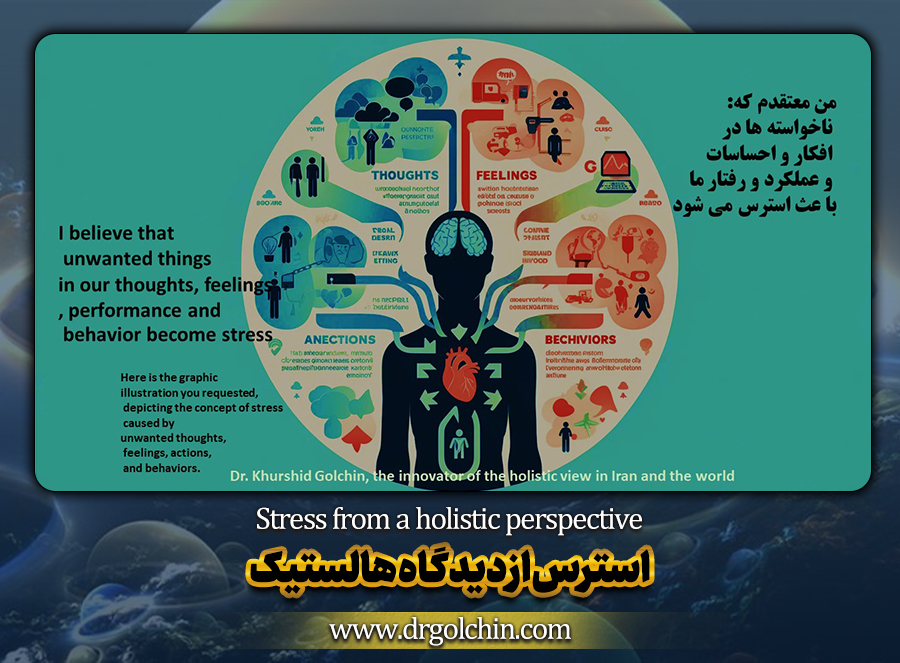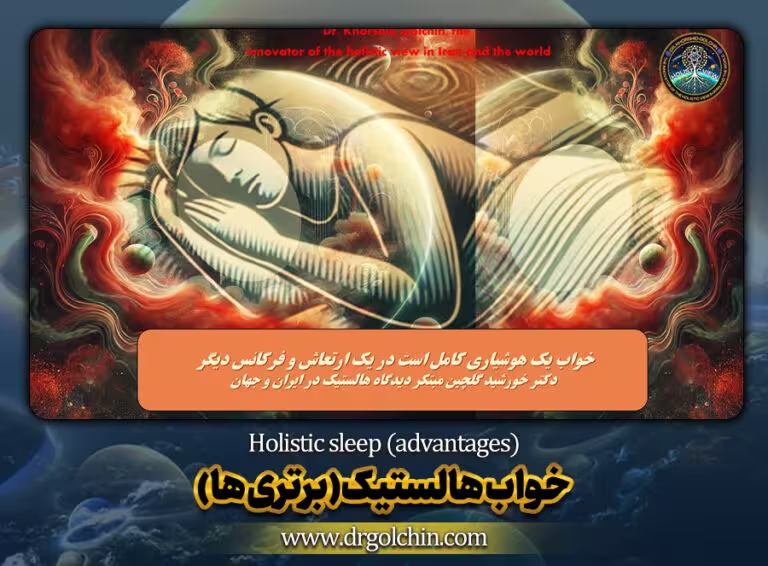استرس از دیدگاه هالستیک

دکتر خورشید گلچین مبتکر دیدگاه هالستیک در ایران و جهان هستم ، معتقدم که استرس در اثر ناخواسته ها در فکر و احساس و عملکرد و رفتار ما بوجود می آید استرس به عنوان یکی از پدیدههای رایج در زندگی روزمره، بر سلامت جسمی و روانی انسانها تاثیر میگذارد. نظریهها و رویکردهای مختلفی برای بررسی علل استرس مطرح شدهاند. یکی از رویکردهای مهم در این زمینه، رویکرد هالستیک یا کلینگر است که به تعامل میان جسم، ذهن، و روان توجه میکند. دکتر خورشید گلچین با تأکید بر اینکه استرس از ناخواستهها در فکر، احساس، عملکرد و رفتار ناشی میشود، دیدگاه متفاوتی نسبت به عوامل استرسزا ارائه میدهد. این تحلیل بر مبنای این دیدگاه است که چگونه ناخواستهها میتوانند در چهار بعد اصلی ذهن انسان (فکر، احساس، عملکرد، و رفتار) به شکلگیری استرس منجر شوند. در ادامه با مقاله استرس از دیدگاه هالستیک همراه باشید
فهرست عناوین
استرس در نتیجه ناخواستههای فکری
افکار ما یکی از منابع اصلی بروز استرس هستند. افکاری که بر روی موارد ناخواسته و غیرقابل کنترل متمرکز میشوند، به ایجاد استرس منجر میشوند. این افکار میتوانند شامل نگرانی درباره آینده، احساس ناتوانی در کنترل شرایط و ارزیابی منفی از تواناییهای فرد باشند. زمانی که فرد دائماً بر ناخواستهها در فکر تمرکز میکند، نه تنها ذهن خود را تحت فشار قرار میدهد، بلکه توانایی خود در یافتن راهحلهای مناسب را نیز کاهش میدهد.
مثالهای ناخواستههای فکری در استرس از دیدگاه هالستیک
- نگرانی مداوم درباره وضعیت اقتصادی.
- افکار منفی درباره روابط اجتماعی.
- احساس ترس از شکست در امتحانات یا پروژههای کاری.
- نگرانی از بیماریهای جسمی یا روانی بدون نشانه مشخص.
- احساس عدم کنترل بر زندگی شخصی.
استرس در نتیجه ناخواستههای احساسی
احساسات ناخواسته، به ویژه احساساتی مانند ترس، اضطراب و ناامیدی، میتوانند عامل استرس باشند. این احساسات زمانی که به صورت ناگهانی یا به دلیل رویدادهای غیرمنتظره ظاهر میشوند، میتوانند تعادل عاطفی فرد را به هم بزنند و او را در وضعیت استرس قرار دهند. برای مثال، فردی که به دلیل یک تجربه تلخ گذشته همواره احساس ناامنی میکند، ممکن است حتی در موقعیتهای عادی نیز دچار استرس شود.
مثالهای ناخواستههای احساسی در استرس از دیدگاه هالستیک
احساس ترس مداوم از ناشناختهها.
- اضطراب در موقعیتهای اجتماعی.
- ناامیدی از آینده بدون دلیل مشخص.
- حس گناه به دلیل وقایع گذشته.
- احساس تنهایی و بیپناهی حتی در میان جمع.
استرس در نتیجه ناخواستههای عملکردی
ناخواستههای عملکردی به معنای شرایطی هستند که فرد مجبور به انجام کاری است که آن را نمیخواهد یا نمیتواند به خوبی انجام دهد. این نوع ناخواستهها معمولاً در محیط کاری یا تحصیلی دیده میشوند، جایی که فرد باید وظایفی را بر عهده بگیرد که با تواناییها، علاقهها یا شرایط شخصی او سازگاری ندارند. فشار برای انجام این وظایف به شکلگیری استرس منجر میشود، به ویژه اگر فرد احساس کند که از سوی دیگران قضاوت میشود.
مثالهای ناخواستههای عملکردی در استرس از دیدگاه هالستیک
- انجام وظایفی که با علاقههای فرد سازگار نیستند.
- مواجهه با مهلتهای زمانی غیرمنطقی در محیط کار.
- کار در شرایطی که فرد از منابع یا پشتیبانی کافی برخوردار نیست.
- تحمیل مسئولیتهای غیرمتناسب با تواناییها.
- انجام کاری که فرد احساس میکند هیچ کنترلی بر نتیجه آن ندارد.
استرس در نتیجه ناخواستههای رفتاری
رفتارهای ما میتوانند به عنوان یک واکنش به ناخواستهها، باعث ایجاد استرس شوند. زمانی که فرد درگیر رفتارهایی میشود که خود نمیخواهد یا به دلیل فشارهای خارجی به آنها تن داده است، نوعی ناهماهنگی روانی و عاطفی شکل میگیرد که منجر به استرس میشود. این رفتارها ممکن است شامل تعهدات اجتماعی یا حرفهای باشند که فرد احساس میکند به اجبار وارد آنها شده است.
مثالهای ناخواستههای رفتاری در استرس از دیدگاه هالستیک
- حضور در موقعیتهای اجتماعی که فرد از آنها لذت نمیبرد.
- مشارکت در پروژههای گروهی که فرد احساس میکند نقش مناسبی در آن ندارد.
- پذیرش مسئولیتهای اضافی به دلیل فشارهای خانوادگی یا اجتماعی.
- انجام رفتارهایی که با ارزشها یا باورهای شخصی فرد تناقض دارند.
- تطبیق با رفتارهای گروهی که فرد احساس میکند به آنها تعلق ندارد.
نتیجهگیری مقاله استرس از دیدگاه هالستیک
استرس به عنوان یک پدیده پیچیده میتواند از تعامل میان ذهن، جسم و محیط فرد نشأت بگیرد. دیدگاه هالستیک دکتر خورشید گلچین بر این باور است که استرس نه تنها ناشی از عوامل بیرونی بلکه بیشتر از طریق ناخواستههایی که در فکر، احساس، عملکرد و رفتار ما شکل میگیرند، به وجود میآید. این ناخواستهها بهطور مستقیم ذهن و جسم فرد را تحت فشار قرار داده و منجر به ایجاد استرس میشوند. مدیریت استرس نیازمند شناخت این ناخواستهها و یافتن راههای مؤثر برای مقابله با آنهاست.
Dr. Khurshid Golchin, I am the originator of the holistic view in Iran and the world, I believe that stress is caused by unwanted things in our thoughts, feelings, performance and behavior. (Stress from a holistic perspective)
Analysis of Stress Arising from Undesirable Thoughts, Feelings, Actions, and Behaviors
Introduction
Stress is a common phenomenon that affects both physical and mental well-being. Various theories have been proposed to explain the causes of stress, and one of the key approaches is the holistic view, which emphasizes the interaction between the body, mind, and emotions. Dr. Khorshid Golchin, an advocate of holistic approaches, believes that stress originates from undesirable elements in our thoughts, feelings, actions, and behaviors. This analysis explores how these “undesirables” can lead to stress in four core aspects of human mental life: thought, emotion, action, and behavior.
Stress from Undesirable Thoughts
Our thoughts are a primary source of stress, particularly when they focus on unwanted or uncontrollable aspects of life. Such thoughts may include worrying about the future, feeling powerless to control situations, or assessing oneself negatively. When a person continuously focuses on undesirable thoughts, it not only strains their mind but also reduces their ability to find suitable solutions.
Examples of Undesirable Thoughts:
- Constant worry about financial stability.
- Negative thoughts about social relationships.
- Fear of failure in exams or professional projects.
- Anxiety over health issues without clear symptoms.
- Feeling a lack of control over personal life.
Stress from Undesirable Emotions
Undesirable emotions, particularly those like fear, anxiety, and hopelessness, are key contributors to stress. These emotions can appear suddenly or be triggered by unexpected events, disrupting a person’s emotional balance and causing stress. For example, someone who feels insecure due to past trauma may experience stress even in normal situations.
Examples of Undesirable Emotions:
- Constant fear of the unknown.
- Anxiety in social situations.
- Unexplained hopelessness about the future.
- Guilt over past events.
- Feeling lonely or unsupported, even in the presence of others.
Stress from Undesirable Actions
Undesirable actions refer to situations where a person is forced to perform tasks they either do not want to do or feel incapable of doing effectively. These situations often arise in work or educational settings where a person is required to take on tasks that do not align with their abilities, interests, or personal circumstances. The pressure to perform these tasks can lead to stress, particularly when the individual feels judged by others.
Examples of Undesirable Actions:
- Completing tasks that do not align with personal interests.
- Facing unrealistic deadlines at work.
- Working in conditions where one lacks adequate resources or support.
- Being assigned responsibilities disproportionate to one’s abilities.
- Engaging in tasks where one feels they have no control over the outcome.
Stress from Undesirable Behaviors
Our behaviors, especially when shaped by external pressures or situations, can also lead to stress. When a person is forced into behaviors they do not want or that conflict with their internal desires, it creates psychological and emotional tension, which in turn results in stress. Such behaviors may include participating in social or professional commitments that the individual feels compelled to accept.
Examples of Undesirable Behaviors:
- Attending social events that one does not enjoy.
- Participating in group projects where one feels their role is inadequate.
- Accepting additional responsibilities due to family or social pressure.
- Acting in ways that conflict with one’s personal values or beliefs.
- Adopting group behaviors that make one feel disconnected or alienated.
Conclusion
Stress is a complex phenomenon that emerges from the interplay between the mind, body, and environment. Dr. Khorshid Golchin’s holistic perspective emphasizes that stress is not only caused by external factors but also arises from undesirable elements in our thoughts, emotions, actions, and behaviors. These undesirables directly impact the mind and body, leading to stress. Effectively managing stress requires recognizing these undesirables and finding practical ways to cope with them.





